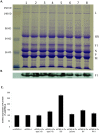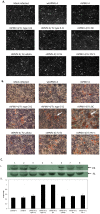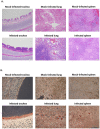Mutations in the fusion protein cleavage site of avian paramyxovirus serotype 4 confer increased replication and syncytium formation in vitro but not increased replication and pathogenicity in chickens and ducks
- PMID: 23341874
- PMCID: PMC3544850
- DOI: 10.1371/journal.pone.0050598
Mutations in the fusion protein cleavage site of avian paramyxovirus serotype 4 confer increased replication and syncytium formation in vitro but not increased replication and pathogenicity in chickens and ducks
Retraction in
-
Retraction: Mutations in the Fusion Protein Cleavage Site of Avian Paramyxovirus Serotype 4 Confer Increased Replication and Syncytium Formation In Vitro but Not Increased Replication and Pathogenicity in Chickens and Ducks.PLoS One. 2020 Dec 14;15(12):e0244076. doi: 10.1371/journal.pone.0244076. eCollection 2020. PLoS One. 2020. PMID: 33315953 Free PMC article. No abstract available.
Abstract
To evaluate the role of the F protein cleavage site in the replication and pathogenicity of avian paramyxoviruses (APMVs), we constructed a reverse genetics system for recovery of infectious recombinant APMV-4 from cloned cDNA. The recovered recombinant APMV-4 resembled the biological virus in growth characteristics in vitro and in pathogenicity in vivo. The F cleavage site sequence of APMV-4 (DIQPR↓F) contains a single basic amino acid, at the -1 position. Six mutant APMV-4 viruses were recovered in which the F protein cleavage site was mutated to contain increased numbers of basic amino acids or to mimic the naturally occurring cleavage sites of several paramyxoviruses, including neurovirulent and avirulent strains of NDV. The presence of a glutamine residue at the -3 position was found to be important for mutant virus recovery. In addition, cleavage sites containing the furin protease motif conferred increased replication and syncytium formation in vitro. However, analysis of viral pathogenicity in 9-day-old embryonated chicken eggs, 1-day-old and 2-week-old chickens, and 3-week-old ducks showed that none the F protein cleavage site mutations altered the replication, tropism, and pathogenicity of APMV-4, and no significant differences were observed among the parental and mutant APMV-4 viruses in vivo. Although parental and mutant viruses replicated somewhat better in ducks than in chickens, they all were highly restricted and avirulent in both species. These results suggested that the cleavage site sequence of the F protein is not a limiting determinant of APMV-4 pathogenicity in chickens and ducks.
Conflict of interest statement
Figures








Comment in
-
Findings of Research Misconduct.Fed Regist. 2020 May 13;85(93):28643-28645. Fed Regist. 2020. PMID: 32435075 Free PMC article. No abstract available.
Similar articles
-
Mutations in the fusion protein cleavage site of avian paramyxovirus serotype 2 increase cleavability and syncytium formation but do not increase viral virulence in chickens.J Virol. 2011 Jun;85(11):5394-405. doi: 10.1128/JVI.02696-10. Epub 2011 Mar 30. J Virol. 2011. PMID: 21450835 Free PMC article.
-
Replication, neurotropism, and pathogenicity of avian paramyxovirus serotypes 1-9 in chickens and ducks.PLoS One. 2012;7(4):e34927. doi: 10.1371/journal.pone.0034927. Epub 2012 Apr 30. PLoS One. 2012. Retraction in: PLoS One. 2020 Dec 14;15(12):e0244178. doi: 10.1371/journal.pone.0244178. PMID: 22558104 Free PMC article. Retracted.
-
Mutation of the f-protein cleavage site of avian paramyxovirus type 7 results in furin cleavage, fusion promotion, and increased replication in vitro but not increased replication, tissue tropism, or virulence in chickens.J Virol. 2012 Apr;86(7):3828-38. doi: 10.1128/JVI.06765-11. Epub 2012 Jan 18. J Virol. 2012. PMID: 22258248 Free PMC article.
-
Avian Paramyxovirus: A Brief Review.Transbound Emerg Dis. 2017 Feb;64(1):53-67. doi: 10.1111/tbed.12355. Epub 2015 Apr 28. Transbound Emerg Dis. 2017. PMID: 25924108 Review.
-
Drivers and Distribution of Henipavirus-Induced Syncytia: What Do We Know?Viruses. 2021 Sep 2;13(9):1755. doi: 10.3390/v13091755. Viruses. 2021. PMID: 34578336 Free PMC article. Review.
Cited by
-
The Proteolytic Regulation of Virus Cell Entry by Furin and Other Proprotein Convertases.Viruses. 2019 Sep 9;11(9):837. doi: 10.3390/v11090837. Viruses. 2019. PMID: 31505793 Free PMC article. Review.
-
Review detection of Newcastle disease virus.Front Vet Sci. 2022 Aug 2;9:936251. doi: 10.3389/fvets.2022.936251. eCollection 2022. Front Vet Sci. 2022. PMID: 35982920 Free PMC article. Review.
-
Evaluation of the replication, pathogenicity, and immunogenicity of avian paramyxovirus (APMV) serotypes 2, 3, 4, 5, 7, and 9 in rhesus macaques.PLoS One. 2013 Oct 10;8(10):e75456. doi: 10.1371/journal.pone.0075456. eCollection 2013. PLoS One. 2013. Retraction in: PLoS One. 2020 Dec 14;15(12):e0244045. doi: 10.1371/journal.pone.0244045. PMID: 24130713 Free PMC article. Retracted.
-
Contribution of HN protein length diversity to Newcastle disease virus virulence, replication and biological activities.Sci Rep. 2016 Nov 11;6:36890. doi: 10.1038/srep36890. Sci Rep. 2016. PMID: 27833149 Free PMC article.
-
Characterization of novel avian paramyxovirus strain APMV/Shimane67 isolated from migratory wild geese in Japan.J Vet Med Sci. 2015 Sep;77(9):1079-85. doi: 10.1292/jvms.14-0529. Epub 2015 Apr 11. J Vet Med Sci. 2015. PMID: 25866408 Free PMC article.
References
-
- Lamb R, Parks G (2007) Paramyxoviridae: the viruses and their replication. In: Knipe DM, Howley PM, Griffin DE, Lamb RA, Martin MA, Roizman B, Straus SE, editors. Philadelphia: Lippincott Williams & Wilkins. pp. 1449–1496.
-
- Alexander DJ (2003) Avian paramyxoviruses 2–9. In: Saif, Y.M, (Ed.), Diseases of Poultry, 11th ed. Iowa State University Press, Ames 88–92.
-
- Hu S, Ma H, Wu Y, Liu W, Wang X, et al. (2009) A vaccine candidate of attenuated genotype VII Newcastle disease virus generated by reverse genetics. Vaccine 27: 904–910. - PubMed
-
- Huang Z, Krisnamurthy S, Panda A, Samal SK (2001) High-level expression of a foreign gene from the 3′ proximal first locus of a recombinant Newcastle disease virus. J Gen Virol 82: 1729–1736. - PubMed
Publication types
MeSH terms
Substances
Grants and funding
LinkOut - more resources
Full Text Sources
Other Literature Sources

